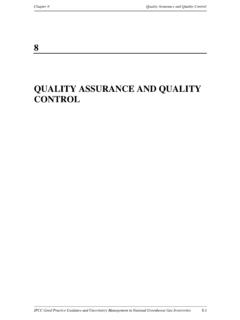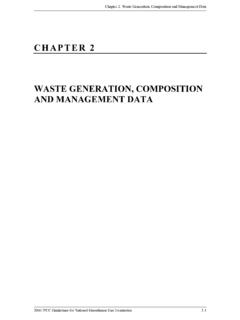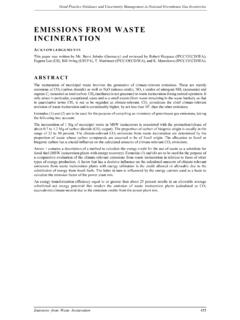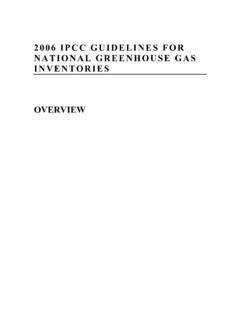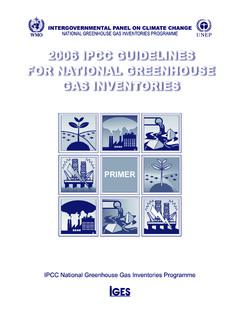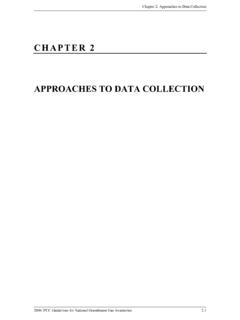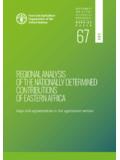Transcription of CHAPTER 6 WASTEWATER TREATMENT AND DISCHARGE
1 CHAPTER 6: WASTEWATER TREATMENT and DISCHARGE CHAPTER 6. WASTEWATER TREATMENT AND. DISCHARGE . 2006 IPCC Guidelines for National Greenhouse Gas Inventories Volume 5: Waste Authors Michiel R. J. Doorn (Netherlands), Sirintornthep Towprayoon (Thailand), Sonia Maria Manso Vieira (Brazil), William Irving (USA), Craig Palmer (Canada), Riitta Pipatti (Finland), and Can Wang (China). 2006 IPCC Guidelines for National Greenhouse Gas Inventories CHAPTER 6: WASTEWATER TREATMENT and DISCHARGE Contents 6 WASTEWATER TREATMENT and DISCHARGE Introduction .. Changes compared to 1996 Guidelines and Good Practice Guidance .. Methane emissions from WASTEWATER .. Methodological issues .. Domestic WASTEWATER .. Choice of method .. Choice of emission factors .. Choice of activity data .. Time series consistency .. Uncertainties .. QA/QC, Completeness, Reporting and Documentation.
2 Industrial WASTEWATER .. Choice of method .. Choice of emission factors .. Choice of activity data .. Time series consistency .. Uncertainties .. QA/QC, Completeness, Reporting and Documentation .. Nitrous oxide emissions from WASTEWATER .. Methodological issues .. Choice of method .. Choice of emission factors .. Choice of activity data .. Time series consistency .. Uncertainties .. QA/QC, Completeness, Reporting and Documentation .. References .. 2006 IPCC Guidelines for National Greenhouse Gas Inventories Volume 5: Waste Equations Equation Total CH4 emissions from domestic WASTEWATER .. Equation CH4 emission factor for each domestic WASTEWATER TREATMENT / DISCHARGE pathway or system .. Equation Total organically degradable material in domestic WASTEWATER .. Equation Total CH4 emissions from industrial WASTEWATER .. Equation CH4 emission factor for industrial WASTEWATER .
3 Equation Organically degradable material in industrial WASTEWATER .. Equation N2O emissions from WASTEWATER effluent .. Equation Total nitrogen in the effluent .. Equation N2O emission from centralized WASTEWATER TREATMENT processes .. Figures Figure WASTEWATER TREATMENT systems and DISCHARGE pathways .. Figure Decision Tree for CH4 emissions from domestic WASTEWATER .. Figure Decision Tree for CH4 emissions from industrial WASTEWATER TREATMENT .. 2006 IPCC Guidelines for National Greenhouse Gas Inventories CHAPTER 6: WASTEWATER TREATMENT and DISCHARGE Tables Table CH4 and N2O emission potentials for WASTEWATER and sludge TREATMENT and DISCHARGE systems .. Table Default maximum CH4 producing capacity (Bo) for domestic WASTEWATER .. Table Default MCF values for domestic WASTEWATER .. Table Estimated BOD5 values in domestic WASTEWATER for selected regions and countries.
4 Table Suggested values for urbanisation (U) and degree of utilisation of TREATMENT , DISCHARGE pathway or method (Ti,j) for each income group for selected countries .. Table Example of the application of default values for degrees of TREATMENT utilization (T). by income groups .. Table Default uncertainty ranges for domestic WASTEWATER .. Table Default MCF values for industrial WASTEWATER .. Table Examples of industrial WASTEWATER data .. Table Default uncertainty ranges for industrial WASTEWATER .. Table N2O methodology default data .. Boxes Box Subcategory - Emissions from advanced centralised WASTEWATER TREATMENT plants .. 2006 IPCC Guidelines for National Greenhouse Gas Inventories Volume 5: Waste 6 WASTEWATER TREATMENT AND. DISCHARGE . INTRODUCTION. WASTEWATER can be a source of methane (CH4) when treated or disposed anaerobically. It can also be a source of nitrous oxide (N2O) emissions.
5 Carbon dioxide (CO2) emissions from WASTEWATER are not considered in the IPCC. Guidelines because these are of biogenic origin and should not be included in national total emissions. WASTEWATER originates from a variety of domestic, commercial and industrial sources and may be treated on site (uncollected), sewered to a centralized plant (collected) or disposed untreated nearby or via an outfall. Domestic WASTEWATER is defined as WASTEWATER from household water use, while industrial WASTEWATER is from industrial practices only. 1 TREATMENT and DISCHARGE systems can sharply differ between countries. Also, TREATMENT and DISCHARGE systems can differ for rural and urban users, and for urban high income and urban low-income users. Sewers may be open or closed. In urban areas in developing countries and some developed countries, sewer systems may consist of networks of open canals, gutters, and ditches, which are referred to as open sewers.
6 In most developed countries and in high-income urban areas in other countries, sewers are usually closed and underground. WASTEWATER in closed underground sewers is not believed to be a significant source of CH4. The situation is different for WASTEWATER in open sewers, because it is subject to heating from the sun and the sewers may be stagnant allowing for anaerobic conditions to emit CH4. (Doorn et al., 1997). The most common WASTEWATER TREATMENT methods in developed countries are centralized aerobic WASTEWATER TREATMENT plants and lagoons for both domestic and industrial WASTEWATER . To avoid high DISCHARGE fees or to meet regulatory standards, many large industrial facilities pre-treat their WASTEWATER before releasing it into the sewage system. Domestic WASTEWATER may also be treated in on-site septic systems. These are advanced systems that may treat WASTEWATER from one or several households.
7 They consist of an anaerobic underground tank and a drainage field for the TREATMENT of effluent from the tank. Some developed countries continue to dispose of untreated domestic WASTEWATER via an outfall or pipeline into a water body, such as the ocean. The degree of WASTEWATER TREATMENT varies in most developing countries. In some cases industrial WASTEWATER is discharged directly into bodies of water, while major industrial facilities may have comprehensive in-plant TREATMENT . Domestic WASTEWATER is treated in centralized plants, pit latrines, septic systems or disposed of in unmanaged lagoons or waterways, via open or closed sewers. In some coastal cities domestic WASTEWATER is discharged directly into the ocean. Pit latrines are lined or unlined holes of up to several meters deep, which may be fitted with a toilet for convenience. Figure shows different pathways for WASTEWATER TREATMENT and DISCHARGE .
8 Centralized WASTEWATER TREATMENT methods can be classified as primary, secondary, and tertiary TREATMENT . In primary TREATMENT , physical barriers remove larger solids from the WASTEWATER . Remaining particulates are then allowed to settle. Secondary TREATMENT consists of a combination of biological processes that promote biodegradation by micro-organisms. These may include aerobic stabilisation ponds, trickling filters, and activated sludge processes, as well as anaerobic reactors and lagoons. Tertiary TREATMENT processes are used to further purify the WASTEWATER of pathogens, contaminants, and remaining nutrients such as nitrogen and phosphorus compounds. This is achieved using one or a combination of processes that can include maturation/polishing ponds, biological processes, advanced filtration, carbon adsorption, ion exchange, and disinfection.
9 Sludge is produced in all of the primary, secondary and tertiary stages of TREATMENT . Sludge that is produced in primary TREATMENT consists of solids that are removed from the WASTEWATER and is not accounted for in this category. Sludge produced in secondary and tertiary TREATMENT results from biological growth in the biomass, as well as the collection of small particles. This sludge must be treated further before it can be safely disposed of. Methods of sludge TREATMENT include aerobic and anaerobic stabilisation (digestion), conditioning, centrifugation, composting, and drying. Land disposal, composting, and incineration of sludge is considered in Volume 5, Section in CHAPTER 2, Waste Generation, Composition, and Management Data, Section in CHAPTER 3, Solid Waste Disposal, Section in CHAPTER 4, Biological TREATMENT and Disposal, and CHAPTER 5, Incineration and Open Burning of Waste, respectively.
10 Some sludge is incinerated before land disposal. N2O emissions from sludge and WASTEWATER spread on agricultural land are considered in Section , N2O emissions from managed 1. Because the methodology is on a per person basis, emissions from commercial WASTEWATER are estimated as part of domestic WASTEWATER . To avoid confusion, the term municipal WASTEWATER is not used in this text. Municipal WASTEWATER is a mix of household, commercial and non-hazardous industrial WASTEWATER , treated at WASTEWATER TREATMENT plants. 2006 IPCC Guidelines for National Greenhouse Gas Inventories CHAPTER 6: WASTEWATER TREATMENT and DISCHARGE soils, in CHAPTER 11, N2O Emissions from Managed Soils, and CO2 Emissions from Lime and Urea Application, in Volume 4 of the Agriculture, Forestry, and Other Land Use (AFOLU) Sector. Figure WASTEWATER TREATMENT systems and DISCHARGE pathways Domestic/industrial WASTEWATER Collected Uncollected Untreated Treated Treated on site Untreated Domestic: latrine, septic tank Stagnant Sewered to Industrial: on site plant Rivers, lakes, estuaries, sea sewer plant Rivers, lakes, To Wetland estuaries, sea ground Aerobic TREATMENT Anaerobic TREATMENT Sludge Reactor Lagoon Anaerobic Land Landfill or Digestion Disposal Incineration Note: Emissions from boxes with bold frames are accounted for in this CHAPTER .
